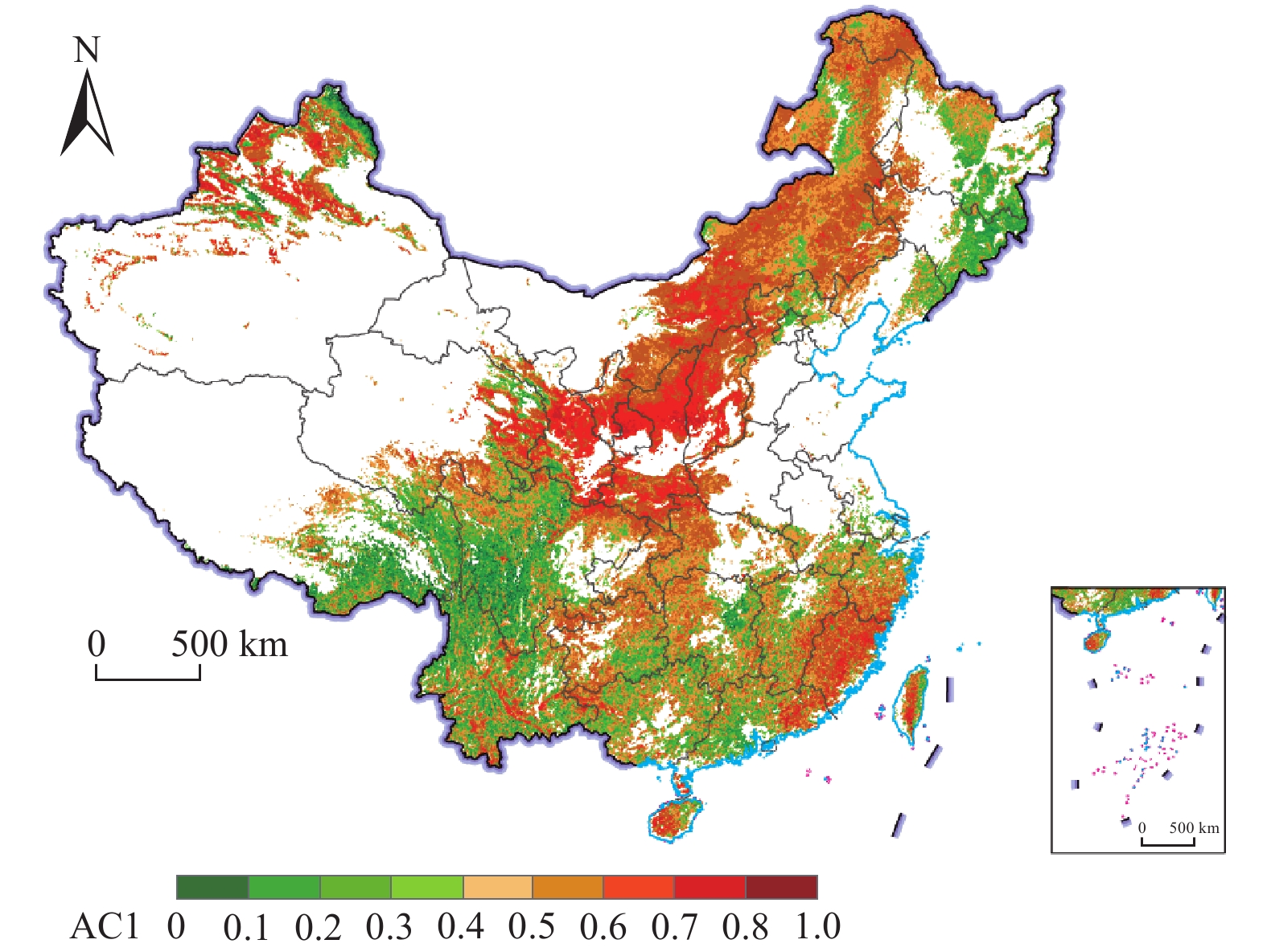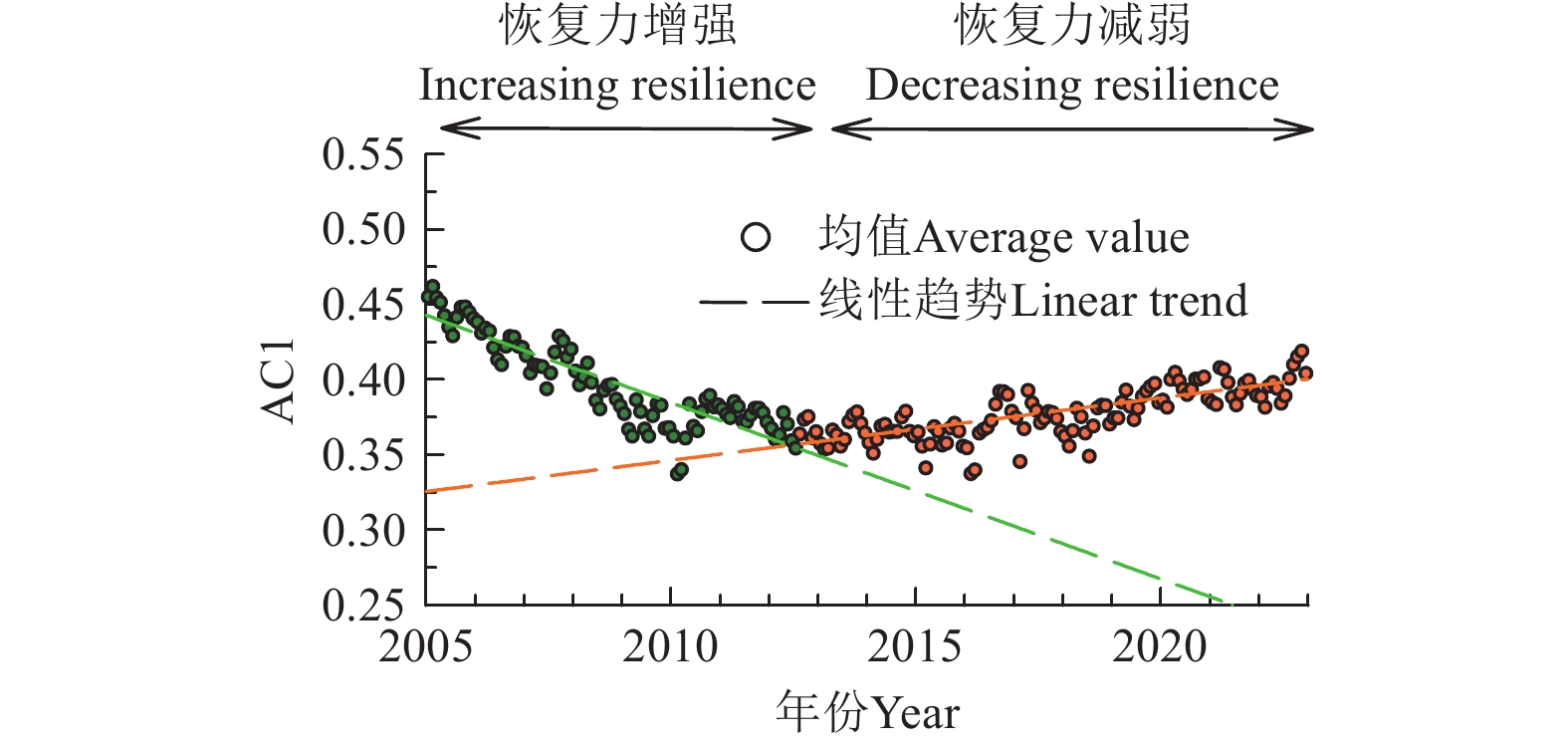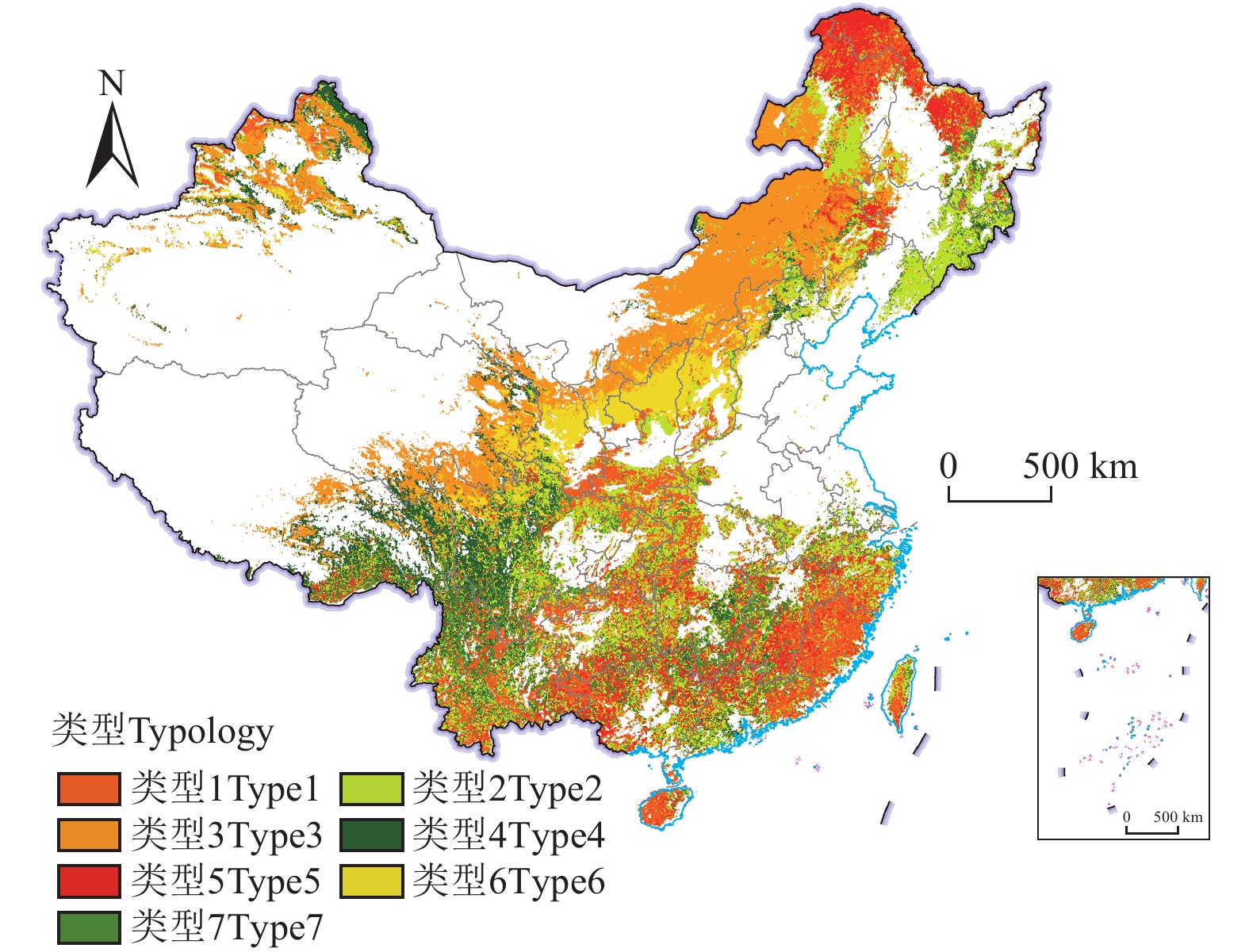Spatiotemporal characteristics and variation tendency of vegetation resilience over China during 2000-2022
-
摘要:
在全球气候变暖背景下,极端干旱热浪事件频发,植被抵御极端事件并从中恢复的能力遭遇严重挑战。该研究利用在轨道碳观测卫星-2(orbiting carbon observatory 2,OCO-2)的日光诱导叶绿素荧光(solar induced chlorophyll fluorescence,SIF)数据基础上优化生成的Global Orbiting Carbon Observatory-2 based Solar Induced chlorophyll Fluorescence(GOSIF)数据,分析了2000—2022年中国植被恢复力的时空特征及演变趋势,研究结果表明:1)中国植被恢复力整体呈现南方好、北方差的空间格局;2)结合一阶滞后自相关系数(lag-one autocorrelation,AC1)和方差的趋势分析结果显示,全国植被恢复力总体呈减弱趋势,与2000—2010年相比,2011—2022年恢复力呈减弱趋势的网格增加了24.28%,主要集中在黄河流域、长江中上游流域及珠江流域;3)就全国平均而言,植被恢复力发生变化的转折点出现在2013年,西南地区、东南沿海及珠江流域的植被恢复力转折出现时间较早,川渝贵鄂的山区、黄河流域、内蒙古中东部及新疆北部植被恢复力的变化与全国同步,内蒙古与黑龙江北部交界处植被恢复力出现转折时间较晚。该研究成果可为中国植被生态系统的修复与保护提供理论基础。
Abstract:Vegetation is an essential component of the terrestrial ecosystem, which plays a crucial role in facilitating material and energy exchanges among the soil, water, and atmosphere. In the context of global warming, climate extremes such as drought and heatwave events become more frequent. These extreme events threaten vegetation growth, leading to vegetation degradation and causing serious impacts on the structure and function of the terrestrial ecosystem. With the weakening of vegetation resistance to extreme dry and hot events, it has also been challenging for it to recover to its original state. To better cope with the risks of ecosystem degradation in a warming environment, it is necessary to evaluate the spatiotemporal patterns of vegetation resilience and its variation tendency. In this study, we used the Global Orbiting Carbon Observatory-2 based Solar Induced chlorophyll Fluorescence (GOSIF) satellite gridded data at a spatial resolution of 0.05° and eight day-interval during 2000-2022 to analyze the trend and spatial patterns of vegetation resilience over China. Based on the concept of the critical slowing down, the lag-one autocorrelation (AC1) and variance were employed as two indicators of the early-warning signals for the critical transitions of vegetation state. On this basis, the Kendall test was used to examine the trend of vegetation resilience, and the k-means clustering method based on the elbow method was employed to classify the different types of vegetation resilience. The results showed that spatially the vegetation resilience over China generally presents a decreasing pattern from south to north. Spatially, the lowest vegetation resilience was found in the Yellow River Basin, while vegetation resilience was generally high in Southwest China such as Sichuan and Yunnan provinces, and eastern parts of North China. Except for the northern parts of the Heilongjiang province and Inner Mongolia, the trends indicated by the AC1 and variance series were generally similar, where the vegetation resilience in most regions over China presented a decreasing pattern during 2000-2022. Compared with the period of 2000-2010, grid cells with enhanced vegetation resilience decreased by 31.04%, and grid cells with weakened vegetation resilience increased by 24.28% during 2011-2022, mainly distributed in the Yellow River Basin, upper and middle reaches of the Yangtze River Basin, Pearl River Basin. A tipping point of the vegetation resilience over China on average occurred in 2013. According to the k-means clustering method, the variation patterns of vegetation resilience were classified into seven groups. The tipping points of vegetation resilience in southwestern China, southeastern coastal areas, and the Pearl River Basin occurred earlier than the national average, while the tipping points in mountain areas in southern China, the Yellow River Basin, central Inner Mongolia and northern Xinjiang were the same as the national average. In contrast, the tipping points of vegetation resilience at the junction of Inner Mongolia and northern Heilongjiang were later than the national average. The results have implications for understanding the temporal characteristics and spatial heterogeneity of vegetation resilience over China, which are also promising to provide some references for the vegetation ecological restoration and protection strategies in China.
-
Keywords:
- vegetation resilience /
- SIF /
- spatiotemporal characteristics /
- variation tendency
-
-
-
[1] FOLKE C, CARPENTER S, WALKER B, et al. Regime shifts, resilience, and biodiversity in ecosystem management[J]. Annual Review of Ecology, Evolution, and Systematics, 2004, 35(1): 557-581. doi: 10.1146/annurev.ecolsys.35.021103.105711
[2] ALLEN C D, MACALADY A K, CHENCHOUNI H, et al. A global overview of drought and heat-induced tree mortality reveals emerging climate change risks for forests[J]. Forest Ecology and Management, 2010, 259(4): 660-684. doi: 10.1016/j.foreco.2009.09.001
[3] 张添佑,陈智,温仲明,等. 陆地生态系统临界转换理论及其生态学机制研究进展[J]. 应用生态学报,2022,33(3):613-622. ZHANG Tianyou, CHEN Zhi, WEN Zhongming, et al. Research advances in critical transition and its ecological mechanisms of terrestrial ecosystems.[J]. Chinese Journal of Applied Ecology, 2022, 33(3): 613-622. (in Chinese with English abstract)
[4] 陈效逑,王恒. 1982—2003年内蒙古植被带和植被覆盖度的时空变化[J]. 地理学报,2009,64(1):84-94. CHEN Xiaoqiu, WANG Heng. Spatial and temporal variations of vegetation belts and vegetation cover degrees in Inner Mongolia from 1982 to 2003[J]. Acta Geographica Sinica, 2009, 64(1): 84-94. (in Chinese with English abstract)
[5] PARMESAN C, YOHE G. A globally coherent fingerprint of climate change impacts across natural systems[J]. Nature, 2003, 421(6918): 37-42. doi: 10.1038/nature01286
[6] 孙艳玲,郭鹏,延晓冬,等. 内蒙古植被覆盖变化及其与气候、人类活动的关系[J]. 自然资源学报,2010,25(3):407-414. SUN Yanling, GUO Peng, YAN Xiaodong, et al. Dynamics of vegetation cover and its relationship with climate change and human activities in Inner Mongolia[J]. Journal of Natural Resources, 2010, 25(3): 407-414. (in Chinese with English abstract)
[7] HOLLING C S. Resilience and stability of ecological systems[J]. Annual Review of Ecology and Systematics, 1973, 4(1): 1-23.
[8] WILLIS K J, JEFFERS E S, TOVAR C. What makes a terrestrial ecosystem resilient?[J]. Science, 2018, 359(6379): 988-989. doi: 10.1126/science.aar5439
[9] PIMM S L. The complexity and stability of ecosystems[J]. Nature, 1984, 307(5949): 321-326. doi: 10.1038/307321a0
[10] 袁媛,白中科. 基于文献计量分析的生态系统恢复力研究进展[J]. 农业工程学报,2020,36(3):271-278. YUAN Yuan, BAI Zhongke. Research progress of ecosystem resilience based on bibliometric investigation[J]. Transactions of the Chinese Society of Agricultural Engineering (Transactions of the CSAE), 2020, 36(3): 271-278. (in Chinese with English abstract)
[11] 张琨,吕一河,傅伯杰. 黄土高原典型区植被恢复及其对生态系统服务的影响[J]. 生态与农村环境学报,2017,33(1):23-31. ZHANG Kun, LÜ Yihe, FU Bojie. Vegetation restoration and its influences on ecosystem services in areas typical of the Loess Plateau[J]. Journal of Ecology and Rural Environment, 2017, 33(1): 23-31. (in Chinese with English abstract)
[12] 武锦辉,张亮亮,赵秉琨,等. 基于临界慢化模型和长时间序列叶面积指数的植被及其恢复力遥感监测研究——以三峡库区为例[J]. 生态学报,2023,43(12):5084-5095. WU Jinhui, ZHANG Liangliang, ZHAO Bingkun, et al. Remote sensing assessing of vegetation and its resilience based on critical slowing down model and GLASS LAI: A case study in the Three Gorges Reservoir Area[J]. Acta Ecologica Sinica, 2023, 43(12): 5084-5095. (in Chinese with English abstract)
[13] 易海杰,张晓萍,何亮,等. 黄土高原不同地貌类型区植被恢复潜力及其土地利用变化[J].农业工程学报,2022,38(18):255-263. YI Haijie, ZHANG Xiaoping, HE Liang, et al. Vegetation restoration potential and land use change in different geomorphological areas of the Loess Plateau[J]. Transactions of the Chinese Society of Agricultural Engineering (Transactions of the CSAE), 2022, 38(18): 255-263. (in Chinese with English abstract)
[14] HODGSON D, MCDONALD J L, HOSKEN D J. What do you mean, ‘resilient’?[J]. Trends in Ecology & Evolution, 2015, 30(9): 503-506.
[15] ZHANG Y, LIU X, JIAO W, et al. Spatial heterogeneity of vegetation resilience changes to different drought types[J]. Earth's Future, 2023, 11(4): e2022EF003108. doi: 10.1029/2022EF003108
[16] 李艳鸽,曹银贵,严子循,等. 恢复力的生态学内涵及量化方法研究综述[J]. 生态与农村环境学报,2024,40(7):841-853. LI Yange, CAO Yingui, YAN Zixun, et al. A review of ecological concepts and quantitative methods of resilience[J]. Journal of Ecology and Rural Environment, 2024, 40(7): 841-853. (in Chinese with English abstract)
[17] SMITH T, TRAXL D, BOERS N. Empirical evidence for recent global shifts in vegetation resilience[J]. Nature Climate Change, 2022, 12(5): 477-484. doi: 10.1038/s41558-022-01352-2
[18] BOERS N, GHIL M, STOCKER T F. Theoretical and paleoclimatic evidence for abrupt transitions in the Earth system[J]. Environmental Research Letters, 2022, 17(9): 093006. doi: 10.1088/1748-9326/ac8944
[19] BOERS N, RYPDAL M. Critical slowing down suggests that the western Greenland Ice Sheet is close to a tipping point[J]. Proceedings of the National Academy of Sciences, 2021, 118(21): e2024192118. doi: 10.1073/pnas.2024192118
[20] FORZIERI G, DAKOS V, MCDOWELL N G, et al. Emerging signals of declining forest resilience under climate change[J]. Nature, 2022, 608(7923): 534-539. doi: 10.1038/s41586-022-04959-9
[21] 吴浩,侯威,颜鹏程. 试用临界慢化原理探讨气候突变[J]. 物理学报,2013,62(3):548-558. WU Hao, HOU Wei, YAN Pengcheng. Using the principle of critical slowing down to discuss the abrupt climate change[J]. Acta Physica Sinica, 2013, 62(3): 548-558. (in Chinese with English abstract)
[22] CARPENTER S R, BROCK W A. Rising variance: a leading indicator of ecological transition[J]. Ecology Letters, 2006, 9(3): 311-318. doi: 10.1111/j.1461-0248.2005.00877.x
[23] DAKOS V, SCHEFFER M, VAN NES E H, et al. Slowing down as an early warning signal for abrupt climate change[J]. Proceedings of the National Academy of Sciences, 2008, 105(38): 14308-14312. doi: 10.1073/pnas.0802430105
[24] WANG Z, FU B, WU X, et al. Vegetation resilience does not increase consistently with greening in China’s Loess Plateau[J]. Communications Earth & Environment, 2023, 4(1): 336.
[25] ZAMPIERI M, GRIZZETTI B, TORETI A, et al. Rise and fall of vegetation annual primary production resilience to climate variability projected by a large ensemble of Earth System Models’ simulations[J]. Environmental Research Letters, 2021, 16(10): 105001. doi: 10.1088/1748-9326/ac2407
[26] 章钊颖,王松寒,邱博,等. 日光诱导叶绿素荧光遥感反演及碳循环应用进展[J]. 遥感学报,2019,23(1):37-52. ZHANG Zhaoying, WANG Songhan, QIU Bo, et al. Retrieval of sun-induced chlorophyll fluorescence and advancements in carbon cycle application[J]. Journal of Remote Sensing, 2019, 23(1): 37-52. (in Chinese with English abstract)
[27] ZHOU Z, DING Y, LIU S, et al. Estimating the applicability of NDVI and SIF to gross primary productivity and grain-yield monitoring in China[J]. Remote Sensing, 2022, 14(13): 3237. doi: 10.3390/rs14133237
[28] SONG L, GUANTER L, GUAN K, et al. Satellite sun‐induced chlorophyll fluorescence detects early response of winter wheat to heat stress in the Indian Indo‐Gangetic Plains[J]. Global Change Biology, 2018, 24(9): 4023-4037. doi: 10.1111/gcb.14302
[29] 王敏钰,罗毅,张正阳,等. 植被物候参数遥感提取与验证方法研究进展[J]. 遥感学报,2022,26(3):431-455. doi: 10.11834/jrs.20211601 WANG Minyu, LUO Yi, ZHANG Zhengyang, et al. Recent advances in remote sensing of vegetation phenology: Retrieval algorithm and validation strategy[J]. National Remote Sensing Bulletin, 2022, 26(3): 431-455. (in Chinese with English abstract) doi: 10.11834/jrs.20211601
[30] HUANG S, TANG L, HUPY J P, et al. A commentary review on the use of normalized difference vegetation index (NDVI) in the era of popular remote sensing[J]. Journal of Forestry Research, 2021, 32(1): 1-6. doi: 10.1007/s11676-020-01155-1
[31] 周稳,迟永刚,周蕾. 基于日光诱导叶绿素荧光的北半球森林物候研究[J]. 植物生态学报,2021,45(4):345-354. doi: 10.17521/cjpe.2020.0376 ZHOU Wen, CHI Yonggang, ZHOU Lei. Vegetation phenology in the Northern Hemisphere based on the solar-induced chlorophyll fluorescence[J]. Chinese Journal of Plant Ecology, 2021, 45(4): 345-354. (in Chinese with English abstract) doi: 10.17521/cjpe.2020.0376
[32] JIAO W, CHANG Q, WANG L. The sensitivity of satellite solar-induced chlorophyll fluorescence to meteorological drought[J]. Earth's Future, 2019, 7(5): 558-573. doi: 10.1029/2018EF001087
[33] MOYA I, CAMENEN L, EVAIN S, et al. A new instrument for passive remote sensing: 1. Measurements of sunlight-induced chlorophyll fluorescence[J]. Remote Sensing of Environment, 2004, 91(2): 186-197. doi: 10.1016/j.rse.2004.02.012
[34] LI X, XIAO J. A global, 0.05-degree product of solar-induced chlorophyll fluorescence derived from OCO-2, MODIS, and reanalysis data[J]. Remote Sensing, 2019, 11(5): 517. doi: 10.3390/rs11050517
[35] BOULTON C A, LENTON T M, BOERS N. Pronounced loss of Amazon rainforest resilience since the early 2000s[J]. Nature Climate Change, 2022, 12(3): 271-278. doi: 10.1038/s41558-022-01287-8
[36] KENDALL M G. A new measure of rank correlation[J]. Biometrika, 1938, 30(1/2): 81-93. doi: 10.1093/biomet/30.1-2.81
[37] GROGGEL D J. Practical nonparametric statistics[J]. Technometrics, 2000, 42(3): 317-318.
[38] 冯克鹏,田军仓,沈晖. 基于 K-means 聚类分区的西北地区近半个世纪气温变化特征分析[J]. 干旱区地理,2019,42(6):1239-1252. FENG Kepeng, TIAN Juncang, SHEN Hui. Temperature variation characteristics of northwest China based on K-means clustering partition in the past half century[J]. Arid Land Geography, 2019, 42(6): 1239-1252. (in Chinese with English abstract)
[39] WENG Z, NIU J, GUAN H, et al. Three-dimensional linkage between meteorological drought and vegetation drought across China[J]. Science of the Total Environment, 2023, 859: 160300. doi: 10.1016/j.scitotenv.2022.160300
[40] CHEN J, WANG S, SHI H, et al. Radiation and temperature dominate the spatiotemporal variability in resilience of subtropical evergreen forests in China[J]. Frontiers in Forests and Global Change, 2023, 6: 1166481. doi: 10.3389/ffgc.2023.1166481
[41] BOETTNER C, BOERS N. Critical slowing down in dynamical systems driven by nonstationary correlated noise[J]. Physical Review Research, 2022, 4(1): 013230. doi: 10.1103/PhysRevResearch.4.013230
[42] FENG Y, SU H, TANG Z, et al. Reduced resilience of terrestrial ecosystems locally is not reflected on a global scale[J]. Communications Earth & Environment, 2021, 2(1): 88.
[43] DAKOS V, VAN NES E H, D'ODORICO P, et al. Robustness of variance and autocorrelation as indicators of critical slowing down[J]. Ecology, 2012, 93(2): 264-271. doi: 10.1890/11-0889.1
[44] SMITH T, BOERS N. Reliability of vegetation resilience estimates depends on biomass density[J]. Nature Ecology & Evolution, 2023, 7(11): 1799-1808.
[45] 王会静,郭玉川,白运保,等. 新疆植被动态格局及其对气候的时滞效应[J]. 农业工程学报,2023,39(11):137-145. WANG Huijing, GUO Yuchuan, BAI Yunbao, et al. Dynamic pattern of vegetation in Xinjiang and its time-lag effect on climate[J]. Transactions of the Chinese Society of Agricultural Engineering (Transactions of the CSAE), 2023 ,39(11): 137-145. (in Chinese with English abstract)
[46] 袁媛,李崇银,杨崧. 与厄尔尼诺和拉尼娜相联系的中国南方冬季降水的年代际异常特征[J]. 气象学报,2014,72(2):237-255. YUAN Yuan, LI Chongyin, YANG Song. Decadal anomalies of winter precipitation over southern China in association with El Niño and La Niña[J]. Acta Meteorologica Sinica, 2014, 72(2): 237-255. (in Chinese with English abstract)
[47] YANG Q, MA Z, FAN X, et al. Decadal modulation of precipitation patterns over eastern China by sea surface temperature anomalies[J]. Journal of Climate, 2017, 30(17): 7017-7033. doi: 10.1175/JCLI-D-16-0793.1
[48] 张晗硕,杨肖丽,任立良,等. 中国典型大范围持续干旱事件对大气环流的响应[J]. 农业工程学报,2024,40(16):124-132. ZHANG Hanshuo, YANG Xiaoli, REN Liliang, et al. Response of typical large-scale persistent drought events to atmospheric Circulation in China[J]. Transactions of the Chinese Society of Agricultural Engineering (Transactions of the CSAE), 2024, 40(16): 124-132. (in Chinese with English abstract)
[49] WANG S, HUANG J, HE Y, et al. Combined effects of the Pacific decadal oscillation and El Nino-southern oscillation on global land dry–wet changes[J]. Scientific Reports, 2014, 4(1): 6651. doi: 10.1038/srep06651
[50] ZHONG Z, HE B, WANG Y P, et al. Disentangling the effects of vapor pressure deficit on northern terrestrial vegetation productivity[J]. Science Advances, 2023, 9(32): eadf3166.
[51] 程梦琦,左志燕,蔺邹兴,等.全球陆地饱和水汽压差的年代际突变[J].中国科学:地球科学,2023,53(7):1536-1549. CHENG Mengqi, ZUO Zhiyan, LIN Zhouxing, et al. Thedecadal abrupt change in the global land vapor pressuredeficit[J]. Scientia Sinica (Terrae), 2023, 66(7): 1536-1549. (in Chinese with English abstract)
[52] NOVICK K A, FICKLIN D L, GROSSIORD C, et al. The impacts of rising vapour pressure deficit in natural and managed ecosystems[J]. Plant, Cell & Environment, 2024, 47(9) : 3561-3589.
[53] GROSSIORD C, BUCKLEY T N, CERNUSAK L A, et al. Plant responses to rising vapor pressure deficit[J]. New Phytologist, 2020, 226(6): 1550-1566. doi: 10.1111/nph.16485
[54] MIRABEL A, GIRARDIN M P, METSARANTA J, et al. Increasing atmospheric dryness reduces boreal forest tree growth[J]. Nature Communications, 2023, 14(1): 6901. doi: 10.1038/s41467-023-42466-1
[55] SMITH T, BOERS N. Global vegetation resilience linked to water availability and variability[J]. Nature Communications, 2023, 14(1): 498. doi: 10.1038/s41467-023-36207-7
[56] WEI Y, LU H, WANG J, et al. Dual influence of climate change and anthropogenic activities on the spatiotemporal vegetation dynamics over the Qinghai‐Tibetan plateau from 1981 to 2015[J]. Earth's Future, 2022, 10(5): e2021EF002566. doi: 10.1029/2021EF002566
[57] VERBESSELT J, UMLAUF N, HIROTA M, et al. Remotely sensed resilience of tropical forests[J]. Nature Climate Change, 2016, 6(11): 1028-1031. doi: 10.1038/nclimate3108
[58] 张更喜,王慧敏,粟晓玲,等. 复合干热胁迫下黄土高原夏季植被脆弱性评估[J]. 农业工程学报,2024,40(6):339-346. ZHANG Gengxi, WANG Huimin, SU Xiaoling, et al. Assessing the vegetation vulnerability of Loess Plateau under compound dry and hot climates[J]. Transactions of the Chinese Society of Agricultural Engineering (Transactions of the CSAE), 2024, 40(6): 339-346. (in Chinese with English abstract)
-
期刊类型引用(4)
1. 曹一征,朱国俊,宣奕帆,唐振博,王李科. 启动方式对混流泵内主轴振动和压力脉动特性的影响. 水电与抽水蓄能. 2025(01): 102-108 .  百度学术
百度学术
2. 卢金玲,王阳,代俊航,朱国俊,宣奕帆,王李科. 降速方式对混流泵压力脉动特性的影响. 农业工程学报. 2024(12): 86-95 .  本站查看
本站查看
3. 陈学炳,杨博文,张人会,郭广强,杨军虎. 离心泵进口来流速度扰动不确定性对水力性能及流场的影响. 农业工程学报. 2024(12): 77-85 .  本站查看
本站查看
4. 朱国俊,唐振博,冯建军,罗兴锜. 启动方式对混流泵噪声特性的影响. 农业工程学报. 2023(13): 34-42 .  本站查看
本站查看
其他类型引用(2)





 下载:
下载:










